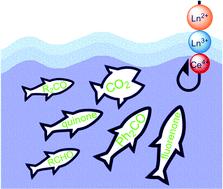当前位置:
X-MOL 学术
›
Dalton Trans.
›
论文详情
Our official English website, www.x-mol.net, welcomes your
feedback! (Note: you will need to create a separate account there.)
Carbonyl group and carbon dioxide activation by rare-earth-metal complexes
Dalton Transactions ( IF 3.5 ) Pub Date : 2020-11-09 , DOI: 10.1039/d0dt03578e Uwe Bayer 1, 2, 3, 4 , Reiner Anwander 1, 2, 3, 4
Dalton Transactions ( IF 3.5 ) Pub Date : 2020-11-09 , DOI: 10.1039/d0dt03578e Uwe Bayer 1, 2, 3, 4 , Reiner Anwander 1, 2, 3, 4
Affiliation

|
The rare-earth elements (Ln = Sc, Y, La–Lu) are widely used in stoichiometric and catalytic carbonyl group transformations. Sufficient availability, non-toxicity, high oxophilicity, tunable ion size/Lewis acidity and enhanced ligand exchangeability have been major driving factors for their successful implementation. Routinely employed reagents for stoichiometric carbonyl group transformations are divalent ytterbium and samarium compounds (e.g., ketone reduction), bimetallic CeCl3/LiR (C–C coupling), or ceric ammonium nitrate CAN (cyclic ketone oxidation). Rare-earth-metal triflates, and in particular Sc(OTf)3, are prominent examples of Lewis acid catalysts for versatile use in organic synthesis (e.g., Aldol and Michael reactions). Moreover, Ln(II) and Ln(III) complexes efficiently catalyze the (co)polymerization of carbonyl group-containing monomers including lactones, lactides, acrylates, and carbon dioxide. Featuring the most notorious greenhouse gas, CO2 is currently assessed as a cheap, abundant, and non-toxic C1 building block. Ln(III) complexes are not only capable of efficient CO2 capture via reversible insertion but also of CO2 activation for catalytic conversions (copolymerization/cycloaddition with epoxides). This perspective focuses on structurally elucidated Ln complexes resulting from ketone or carbonyl derivative activation/insertion as well as carbon dioxide insertion products. The respective compounds will be sorted by structural motifs and, if applicable, details on reactivity and feasibility of catalytic reactions are presented. The article is subdivided in three parts: (i) donor and insertion products of ketones and aldehydes, (ii) redox-enhanced activation of carbonyl derivatives, and (iii) CO2 insertion/redox products and homogeneous catalytic conversion.
中文翻译:

稀土金属络合物活化羰基和二氧化碳
稀土元素(Ln = Sc,Y,La-Lu)广泛用于化学计量和催化羰基转化。足够的可用性,无毒,高亲氧性,可调节的离子尺寸/刘易斯酸度和增强的配体可交换性已成为成功实施的主要驱动因素。用于化学计量的羰基转化的常规试剂是二价和mar化合物(例如,酮还原),双金属CeCl 3 / LiR(CC偶联)或硝酸铈铵CAN(环酮氧化)。稀土三氟甲磺酸酯,尤其是Sc(OTf)3是用于有机合成的路易斯酸催化剂的突出例子(例如,奥尔多和迈克尔的反应)。而且,Ln(II)和Ln(III)配合物有效地催化含羰基的单体(包括内酯,丙交酯,丙烯酸酯和二氧化碳)的(共)聚合。CO 2具有最臭名昭著的温室气体,目前被评估为廉价,丰富且无毒的C1建筑材料。Ln(III)配合物不仅能够通过可逆插入有效捕获CO 2,而且还能够捕获CO 2催化转化的活化(与环氧化物的共聚/环加成反应)。该观点集中在由酮或羰基衍生物的活化/插入以及二氧化碳插入产物产生的结构清晰的Ln络合物上。各个化合物将按结构基序分类,如果适用,还将提供有关反应性和催化反应可行性的详细信息。本文分为三个部分:(i)酮和醛的供体和插入产物;(ii)羰基衍生物的氧化还原增强活化;(iii)CO 2插入/氧化还原产物和均相催化转化。
更新日期:2020-11-25
中文翻译:

稀土金属络合物活化羰基和二氧化碳
稀土元素(Ln = Sc,Y,La-Lu)广泛用于化学计量和催化羰基转化。足够的可用性,无毒,高亲氧性,可调节的离子尺寸/刘易斯酸度和增强的配体可交换性已成为成功实施的主要驱动因素。用于化学计量的羰基转化的常规试剂是二价和mar化合物(例如,酮还原),双金属CeCl 3 / LiR(CC偶联)或硝酸铈铵CAN(环酮氧化)。稀土三氟甲磺酸酯,尤其是Sc(OTf)3是用于有机合成的路易斯酸催化剂的突出例子(例如,奥尔多和迈克尔的反应)。而且,Ln(II)和Ln(III)配合物有效地催化含羰基的单体(包括内酯,丙交酯,丙烯酸酯和二氧化碳)的(共)聚合。CO 2具有最臭名昭著的温室气体,目前被评估为廉价,丰富且无毒的C1建筑材料。Ln(III)配合物不仅能够通过可逆插入有效捕获CO 2,而且还能够捕获CO 2催化转化的活化(与环氧化物的共聚/环加成反应)。该观点集中在由酮或羰基衍生物的活化/插入以及二氧化碳插入产物产生的结构清晰的Ln络合物上。各个化合物将按结构基序分类,如果适用,还将提供有关反应性和催化反应可行性的详细信息。本文分为三个部分:(i)酮和醛的供体和插入产物;(ii)羰基衍生物的氧化还原增强活化;(iii)CO 2插入/氧化还原产物和均相催化转化。











































 京公网安备 11010802027423号
京公网安备 11010802027423号